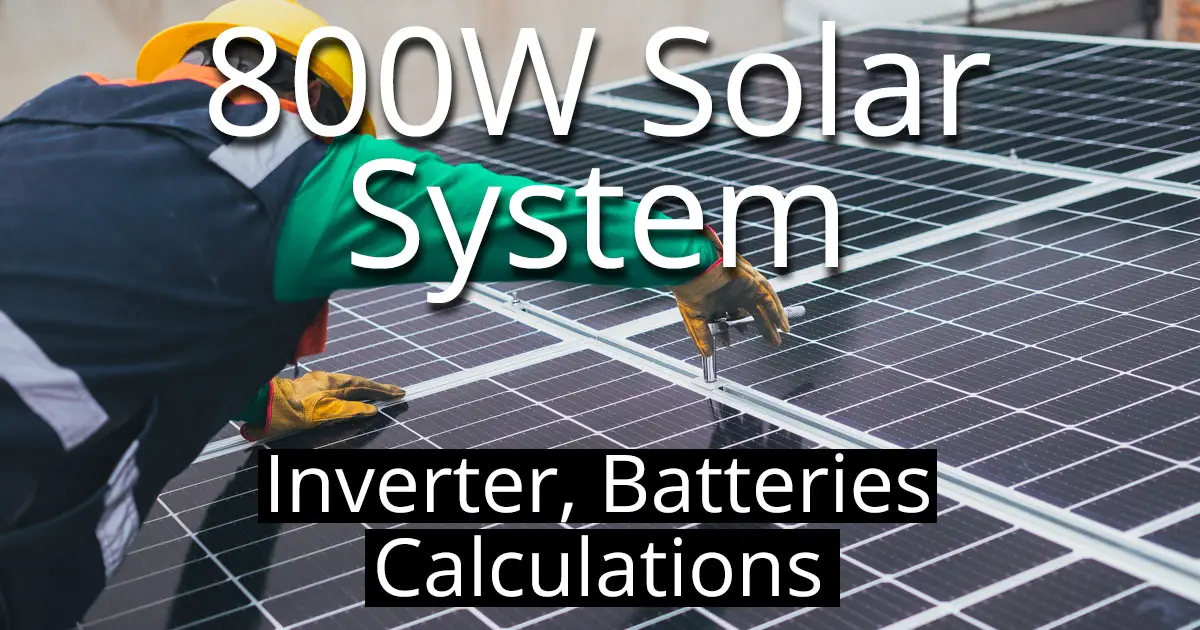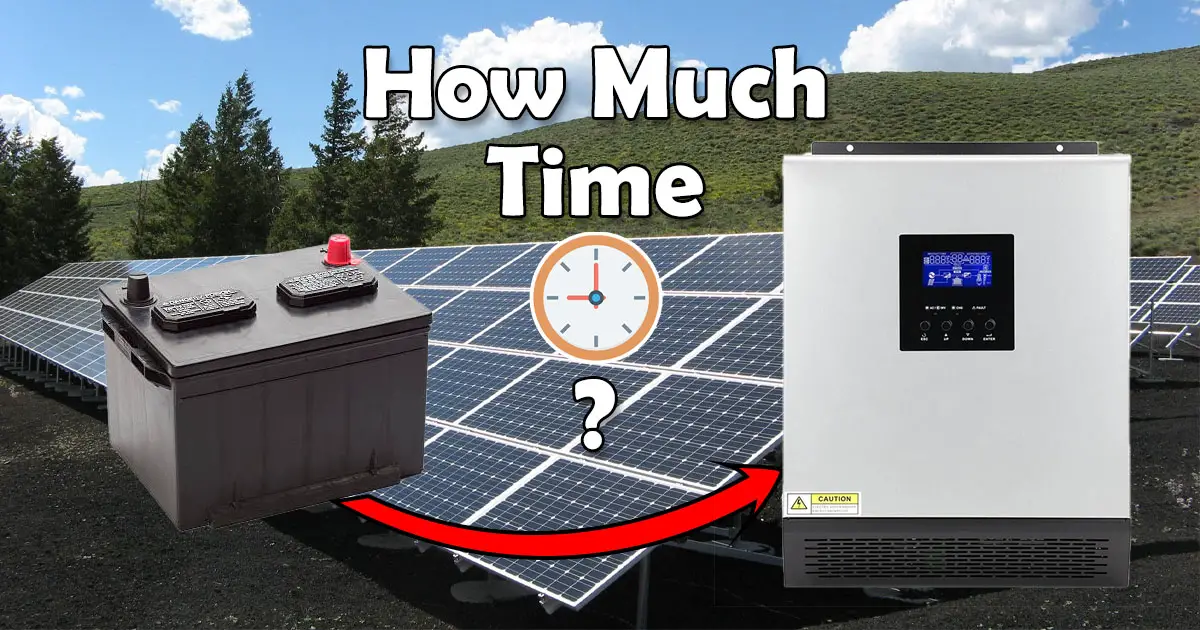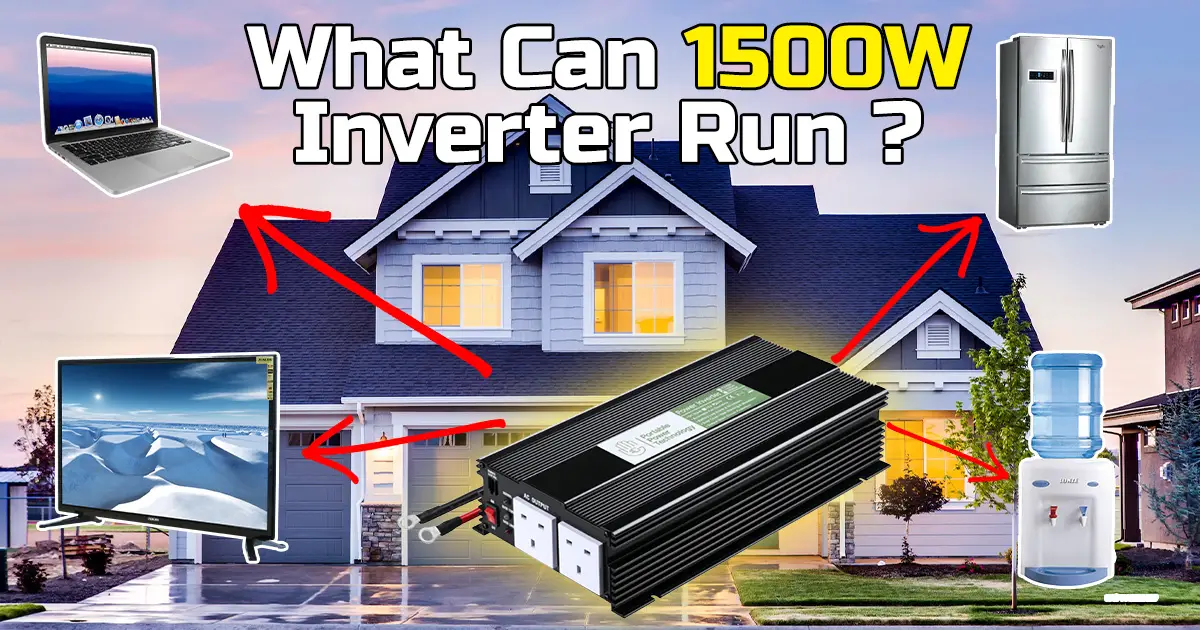Solar power is getting more popular among people in houses, organizations, companies, and even government institutions. However, not all people are of the same economical status and can afford 5kW solar systems and above. So for this reason, many people decided to take advantage of solar power to save some money on electricity bills, but at the same time being on a budget.
The 800-watt solar power system is one of the best solutions to utilize solar power in running some devices during the day and night. However, many questions might come to your mind when building your system. What inverter size could I use for the 800w solar array? How many batteries do I need for the 800w solar system? And many more.
An 800w solar system could have a 1000w solar inverter and two 24v batteries of 200Ah capacity. This estimation is based on 5 peak sun hours, but this could vary widely depending on location and battery storage needed.
Inverter Choosing for 800w Solar System
Choosing the right inverter for your panels depends on multiple factors. Mainly you should focus on the inverter’s maximum DC input power (W) and the MPPT voltage range (V). It is usually thought that the inverter size should be equal to the solar array power. So 800-watt solar array needs an 800-watt solar inverter, and that’s not true.
Undersizing the Inverter
It is sometimes even recommended to undersize the inverter relative to the solar array power. The recommended array-to-inverter ratio is between 1 to 1.55. So if the array was 800w and the ratio is 1.55, the inverter could be 516w. Of course, you will not find a 516w inverter, so you could choose a 600w inverter. However, this is not applicable with low power inverters, it is mostly applicable to 3kW inverters and above, where the max. DC power input is usually higher than the inverter AC power output.
Oversizing the Inverter
You could also choose to oversize the inverter up to 25% more than the solar array. So for example, an 800w solar array could have a 1000w inverter. This is useful if you are planning to expand your solar array in the future.
Examples make things more clear. Let’s say I have 4 renogy solar panels with 200W each, with a total of 800w. These panels have an operating voltage of 22.6 V and an operating current of 8.85 A. Now in the following table, I have chosen multiple solar hybrid inverter examples, some of them will work and some will not.
| Inverter Name | Inverter Specs | Solar Array Connection |
|---|---|---|
| ECO-WORTHY 600W 12V | Voltage Range: 18V-24V Maximum Array Power: 540W | Parallel connection: 22.6V Total Power: 800w |
| HSI Plus 1000w 24v | Maximum Voltage: 100V Maximum Array Power: 900W | Series Connection: 90.4V Total Power: 800w |
| MUST 2000w 24v | Voltage Range: 30V-130V Maximum Array Power: 2000W | Series Connection: 90.4V Total Power: 800w |
These inverters all could be used with the 800w solar array, however, the first one will not take advantage of all the 800w power. This is called power clipping, and the inverter will just use 540w. So for this example, I will choose the HSI Plus 1000w 24v inverter since I am not planning to expand my solar panel’s array anymore. Connecting the solar panels in series will provide a total voltage of 90.4V which is still under the 100V limit.
How Many Batteries Do I Need For The 800w Solar System?
The amount of batteries needed to store solar gathered power depends on multiple factors. Are you going to use your solar system during the day? Or you will just need it at night? Because if you will use it just at night you will need more battery bank capacity to store the power and not lose any of it.
Moreover, the location of your solar power system determines how much power you will be able to store. The type of the battery will also play an important factor in this calculation. In the next section, we will determine the total power generated by this system and how much battery capacity is needed to store it without day consumption.
Just Night Usage Battery Calculations
So if you are going to use this 800w system just at night, this means that all the solar power gathered during the day must be stored in the batteries. So the first step is to determine the power generated by the 800w solar system in your location during the day.
Power Generated During Day (Wh) = Solar Array Power (W) x Peak Sun Hours (h/day)
The peak sun hours is a number that varies from location to location, but it is essential in determining your solar gathered power. You could find your location number from Global Solar Atlas and by referring to this post for an in-depth explanation. In my example, I will choose California US as my location. This gives a value of 6.469 for peak sun hours.
Power Generated During Day = 800W x 6.469h = 5175.2Wh/day
So this means that the 800W solar panels will be producing around 5175.5Wh every day. However there are losses in the wiring, in the inverter, from the environment and shading, etc… So we will deduct 22% as losses from this power.
Total Power Generated During Day = Power Generated During Day x (100 – Losses) %
Total Power Generated During Day = 5175.5 Wh/day x (1 – 0.22) = 4036.89Wh/day
So we have to store every day 4036.89 of solar power in a battery bank. So now we have to find the battery bank capacity, but we need to have the individual battery voltage known. I will choose 24v in consistence with the inverter voltage. We need also to determine the battery type we will buy, so we know how much battery juice we could extract from it, this is known as the depth of discharge (DOD %).
| Battery Type | Depth of Discharge (DOD) % |
|---|---|
| Lithium-ion Batteries | 80% to 95% |
| Lead Acid Batteries | 50% |
| Nickel-cadmium Batteries | 90% |
| Saltwater (Sodium-ion) Batteries | up to 100% |
| Sodium Nickel Chloride Batteries | 80% |
Using this table you could determine your battery DOD, and since we are on a budget, we will use lead acid batteries with 50 % DOD. This means that we could use half of the battery storage. So for example, if I have a 200Ah battery, I could use just 100Ah.
Total Batteries Capacity (Ah) = Total Power Generated During Day (Wh) / ( Battery Voltage (V) x DOD% )
Total Batteries Capacity (Ah) = 4036.89Wh / ( 24V x 0.5 )
Total Batteries Capacity (Ah) = 336.41Ah
So this means that I have to have a battery bank of capacity 336.41Ah of type lead acid and a total voltage of 24V to be able to store all the gathered solar power during the day by the 800W solar panel’s array. Let’s now choose the 200Ah battery type as an example and find how many batteries we need.
Number of batteries = Total Batteries Capacity (Ah) / Individual Battery Capacity (Ah)
Number of batteries = 336.41Ah / 200Ah = 1.68 = 2
So we need 2 lead acid batteries of 200Ah capacity and 24v each. These two batteries must be connected in parallel to have a total voltage of 24v that is compatible with the inverter, and a total capacity of 400Ah, which is greater than the needed capacity (336.41Ah). So this configuration is correct.
Now you could also take a different approach and decide to have 12v batteries:
Total Batteries Capacity (Ah) = Total Power Generated During Day (Wh) / ( Battery Voltage (V) x DOD% )
Total Batteries Capacity (Ah) = 4036.89Wh / ( 12V x 0.5 )
Total Batteries Capacity (Ah) = 672.815Ah
Number of batteries = Total Batteries Capacity (Ah) / Individual Battery Capacity (Ah)
Number of batteries = 672.815Ah / 200Ah = 3.36 = 4
This means that we need 4 lead acid batteries of 200Ah capacity and 12v each. Each two batteries must be connected in series to have a total voltage of 24v and 200Ah capacity. Then these two groups of two batteries will be connected in parallel to have a total voltage of 24v that is compatible with the inverter and a total capacity of 400Ah. Now you might say that this is less than 672.815Ah, but that doesn’t matter, what matters is the total power stored.
Total Power Storage (Wh) = Battery Bank Capacity (Ah) x Battery Bank Voltage (V)
Total Power Storage (Wh) = 400Ah x 24V = 9600Wh
The total power storage is 9600Wh which is greater than double the total power generated during the day (because the DOD is 50%), which is just 8,073.78Wh (4036.89Wh / 0.5). So we are on the safe side, we have space for all this power and even more.
Day And Night Usage Battery Calculations
Now that we know that the 800W solar array is going to produce daily 4036.89Wh in California, we might say that I don’t need all this power to be stored in batteries for night usage. I could use some of them during the day and store the rest. This will lead to a decrease in the number of batteries needed, which in turn reduce the cost. But how could we do this complicated calculation?
We need to create a simple table with the devices that we will be running during the day, the power consumption, and the running duration for each device. Let’s say I will be using an 80W laptop during the day for 3 hours, a 60W fan for 2 hours, a 600W coffee machine for 10 minutes (0.167 hours), a 1000W microwave for 20 minutes (0.333h), and a 1000W bread toaster for 5 minutes (0.083 hours).
| Device | Power (W) | Operating Duration (h) | Power Usage (Wh) |
|---|---|---|---|
| Laptop | 80W | 3h | 240Wh |
| Fan | 60W | 2h | 120Wh |
| Coffee Machine | 600W | 0.167h | 100Wh |
| Microwave | 1000W | 0.333h | 333.333Wh |
| Bread Toaster | 1000W | 0.083 | 83Wh |
| Total: | 2740W | 5.58h | 876.33Wh |
So we will have a total power usage of 876.33Wh during the day. This means that the remaining power to be stored in the batteries for night usage is: 4036.89Wh – 876.33Wh = 3160.56Wh. So now we could perform the same steps as in the previous section but now for 3160.56Wh of total generated power. I will stick to 12v batteries this time.
Total Batteries Capacity (Ah) = Total Power Generated During Day (Wh) / ( Battery Voltage (V) x DOD% )
Total Batteries Capacity (Ah) = 3160.56Wh / ( 12V x 0.5 )
Total Batteries Capacity (Ah) = 526.76Ah
Number of batteries = Total Batteries Capacity (Ah) / Individual Battery Capacity (Ah)
Number of batteries = 526.76Ah / 200Ah = 2.63 = 3
Now choosing a 200Ah is leading to a problem as you could see. We will have 3 lead acid batteries of 12v each and we need the total battery bank voltage to be 24v, which is impossible with 3 12v batteries. So we will decrease the individual battery capacity to 150Ah.
Number of batteries = Total Batteries Capacity (Ah) / Individual Battery Capacity (Ah)
Number of batteries = 526.76Ah / 150Ah = 3.5 = 4
Now we need 4 150Ah lead acid batteries divided into two groups, each group has 2 batteries connected in series, and then the two groups will be connected in parallel. This will result in a battery bank of 24v total voltage which is compatible with the inverter, and a total capacity of 300Ah.
Total Power Storage (Wh) = Battery Bank Capacity (Ah) x Battery Bank Voltage (V)
Total Power Storage (Wh) = 300Ah x 24V = 7200Wh
The total power storage is 7200Wh which is greater than double the total power generated during the day (because the DOD is 50%), which is just 6,321.12Wh (3160.56Wh / 0.5). So we are on the safe side, we have space for all this power and even more.
Backup Days (Autonomy)
Days of autonomy or backup days is something that we need to take into consideration when deciding how many batteries we need. In the previous sections we were able to calculate the needed amount of batteries for one day, but is this enough?
Sometimes you might have cloudy/rainy days where the solar power is even less by more than 50%. So for this reason, it is recommended to have 2 to 5 days of backup. This is of course costly and will lead to doubling or even tripling the system cost.
If you live in a place where most of the year it is sunny, then you are good to go with just one backup day. In my example, California, I will consider 2 days of backup because in the winter we will have might have cloudy days. I will continue from the final result of the previous section:
Number of batteries = ( Total Batteries Capacity (Ah) / Individual Battery Capacity (Ah) ) x Backup Days
Number of batteries = ( 526.76Ah / 150Ah ) x 2 = 7.023 = 8
This means that I will need 8 150Ah lead acid batteries divided into four groups, each group has 2 batteries connected in series, and then the four groups will be connected in parallel. This will result in a battery bank of 24v total voltage which is compatible with the inverter, and a total capacity of 600Ah.
Final Words
The 800 watts solar power system is a balanced system. It provides enough power to run multiple devices in your house/garage/office during the day and night. On the other hand, it is considered an on-budget system that will cost you little money compared to 3kW or 5kW systems.
However, you will be limited to low-power devices, energy-efficient fridges, TVs, laptops, chargers, fans, LED lamps, etc… Even though these devices are low-power devices, they are the mostly used. We turn on the TV daily, we charge our phones 2 or 3 times a day, and of course, we use the light for several hours at night.
For this reason, this small solar power system is considered very useful as it will take a big chunk of your daily electricity usage and will save you a lot in the long run on electricity bills.





